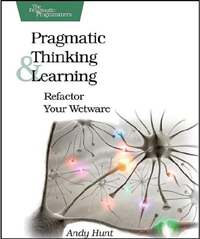read
 |
Pragmatic Thinking and Learning (Paperback, Illustrated Edition) -  앤디 헌트 지음/Pragmatic Pr |
오랜만에 별 다섯개 주는 책이다. Hardware, software 에 대한 책이 아니라 wetware 축축한 그거, 즉 뇌에 대한 이야기다. 우리 뇌가 어떤식으로 동작하는 지를 알고 거기에 맞춰서 ‘어떻게 배울 것인가’ 에 대한 대답을 하는 책이다.
아래는 이 책에 나왔던 팁들을 모아서 적어 봤는데, 역시 결론만 봐서는 당췌 무슨 얘기인지 감이 오지 않으리라. 팁 #1 처럼 책의 Context 속에서 봐야 그 의미를 제대로 알 수 있다.
가장 인상 깊었던 대목은 우뇌를 활용하는 요령에 대한 부분이다. 저자가 얘기하는 것을 맹목적으로 믿을 필요는 없지만, 그 중 상당수는 나도 하고 있던 것과 어느정도 일치하기에 경험상 이 책의 내용에 동의하게 되는 것이다.
끝없는 배움을 동반하는 게 어디 소프트웨어 분야 뿐이랴? 세상 모든 사람들이 늘 뭔가를 배워가며 성장하고 있다. 그 중에서도 무엇을 배워야 하는 가가 명확한 곳이 이 바닥이니, 이제 초점을 “어떻게 배워야 하는가?" 로 옮겨 보는 것도 중요하다 할 수 있다.
[#M_Tips|Close Tips|
- Always consider the context
- Use rules for novices, intuition for experts
- Know what you don’t know
- Learn by watching and imitating
- Keep practicing in order to remain expert
- Avoid formal methods if you need creativity, intuition or inventiveness
- Learn the skill of learning
- Capture all ideas to get more of them
- Learn by synthesis as well as by analysis
- Strive for good design; it really works better
- Rewrite your brain with belief and constant practice
- Add sensory experience to engage more of your brain
- Lead with R-mode; follow with L-mode
- Use metaphor as the meeting place between L-mode and R-mode
- Cultivate humor to build stronger metaphors
- Step away from the keyboard to solve hard problems
- Change your viewpoint to solve the problem
- Watch the outlines; “rarely” doesn’t mean “never”
- Be comfortable with uncertainty
- Trust ink over memory; every mental read is a write
- Hedge your bets with diversity
- Allow for different bugs in different people
- Act like you’ve evolved; breathe, don’t hiss
- Trust intuition, but verify
- Create SMART objectives to reach your goals
- Plan your investment in learning deliberately
- Discover how you learn best
- Form study groups to learn and teach
- Read deliberately
- Take notes with both R-mode and L-mode
- Write on; documenting is more important than documentation
- See it. Do it. Teach it
- Play more in order to learn more
- Learn from similarities; unlearn from differences
- Explore, invent, and apply in your environment – safely
- See without judging and then act
- Give yourself permission to fail; it’s the path to success
- Groove your mind for success
- Learn to pay attention
- Make thinking time
- Use a wiki to manage information and knowledge
- Establish rules of engagement to manage interruptions
- Send less email, you’ll receive less email
- Choose your own tempo for an email conversation
- Mask interrupts to maintain focus
- Use multiple monitors to avoid context switching
- Optimize your personal workflow to maximize context
- Grab the wheel. You can’t steer on autopilot